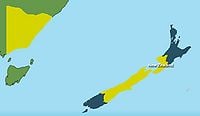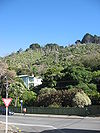New Zealand
| Parts of this article (those related to May 2017) are outdated. |
| Languages: | ||||||||||||||||||||||||||||||||||||||||||||||||||||||||||||||||||||||||||||||||||||||||
| ||||||||||||||||||||||||||||||||||||||||||||||||||||||||||||||||||||||||||||||||||||||||
| ||||||||||||||||||||||||||||||||||||||||||||||||||||||||||||
|
New Zealand is a small country located in the southeastern hemisphere of the New World. On Day 1051, New Zealand became one of the six new countries of eRepublik [1]. The New Zealand IRC channel is #eNewZealand.
 Society
Society
Language
English is the most commonly spoken language in New Zealand, however, many of the nation's residents greet each other by using "Kia Ora" which is Maori for 'hello'. Maori is an indigenous language to New Zealand. Serbian is also a commonly spoken language.
History
Religion
There was one state religion (Kiwism) that believed in a great Golden Kiwi that created New Zealand and the world from holy wool. Unfortunately, the religion never became recognized and soon died.
Geography
New Zealand is a country that is situated in the Southern Hemisphere, bordered by ![]() Australia and
Australia and ![]() Indonesia in the north-west and
Indonesia in the north-west and ![]() Peru and
Peru and ![]() Chile in the east. The population is spread out on two main islands and hundreds of small islands.
Chile in the east. The population is spread out on two main islands and hundreds of small islands.
Historically New Zealand has had all four of its regions but with the passage of time and the general decrease in population, it became increasingly hard to sustain all four regions under their control. Eventually, in late 2014, it was agreed that due to the small population size, NZ would retain one region and rent the other three to neighbors Peru and Chile. This was meant so that a consistent series of resistance wars could take place but also so that NZ could continue function in-game. The agreements, while unpopular with a segment of the population, are deemed the principle reason NZ has yet to be wiped fully.
The original territory of New Zealand is composed of several regions:
Auckland, Canterbury, Otago (occupied by ![]() ), and Wellington.
), and Wellington.
Its current territories are listed below:
| Original Owner | Map | |
| London |
 |
|
| Auckland |  |
|
| Canterbury |  |
|
| Rajasthan |  |
|
| Wellington |  |
 Government and politics
Government and politics
Executive
 Prime Ministers
Prime Ministers
The Prime Minister of New Zealand is elected on the fifth day of every month by the citizens of New Zealand. Upon taking office, a Prime Minister's first set of duties require him to organize his or her cabinet ministers, who assist them in the running of the country.
Premier House, is the official residence of the Prime Minister of New Zealand.
To see more information about the elections for the Prime Minister, check: New Zealand/Presidential Elections
Government Departments and Cabinet of Ministers
 Parliament
Parliament
The Parliament of New Zealand operates through the Congress implemented through the eRepublik system. Members of Parliament (MP's) are elected on the twenty fifth of each month. The entirety of Parliamentary operations is conducted through the New Zealand forums and IRC Chats.
More: NZ Parliamentary Elections
 Parties
Parties
| Logo | Party | Abb. | President | Orientation | Members |
|---|---|---|---|---|---|

|
Ujedinjenje ili smrt | UIS | Djeza | Far-Left, Libertarian | 26 ▼ |

|
Socialist Party of New Zealand | SPNZ | Vatrogasac Draza | Center, Authoritarian | 19 ▲ |

|
Peace 'n' Prosperity Party | PnPP | JarkesH | Centrist, Libertarian | 9 ▼ |

|
Black Party of New Zealand | BPNZ | milosforzajuve | Centre, Libertarian | 6 ▼ |
| |
Maori Party | MP | KrMa | Centre, Libertarian | 4 ▲ |
Last update: May 14, 2017
 Military
Military
New Zealand has a long and proud military history. Its forces consist of a wide variety of citizens from all major backgrounds. Although a young nation, NZ's military history is a proud one. The nation is one of the more powerful military forces in the game, largely due to the concentration of a large contingent of strong fighters within it. This is a legacy of the Serbian and Slovenian migration to the nation during its early months.
Many Kiwis pride themselves on the record of their military. Of the various institutions in NZ, few have the prestige and broad support that the NZ military does. The government takes concrete steps to ensure that business and market forces are regulated in order to help the military. This has sometimes come at the expense of local companies.
Structure
The military structure in NZ has been developed and evolved with time. Considering the relative youth of NZ as a nation within the New World, its military foundations continue to evolve and develop with the passing of time.
Military operations of the New Zealand government is handled by the NZ Ministry of Defence. This usually entails a set of Ministers, appointed by the President who deal with the military affairs of NZ. These ministers are usually drawn from the main political parties of NZ and have experience in military affairs. On most occasions, the President will also cooperate with the military commanders of the respective divisions of the NZ Army.
The New Zealand Army is the primary military organization of New Zealand. It is composed of two divisions,
These units are divided, with the NZSF housing fighters with strength over 2,5000 and the NZDF housing the remainder. Both units were originally part of the NZDF but major reforms to the Army in June 2011 led to the adoption of its current structure.
Foreign Affairs
New Zealand has historically been a non-aligned country. It has usually refused to take part in any of the major alliances that existed within the world and this was one of the traditional policies of neutrality that had been so adhered to by countless NZ governments during the early period of its existence. It featured prominently in political debate and was deemed to have been the consensus of the NZ political class.
However, this changed however during the period of Aotearoa rule, when the government began to shift its affiliation towards what was then the alliance known as ONE. By the later part of 2011, NZ had become a ONE aligned nation and has developed stronger ties with those nations. It soon ceased to be considered a neutral nation and developed friendly ties with other ONE nations, especially Serbia, Slovenia and Indonesia (the later much to the annoyance of Australia.
Historically New Zealand has sought to remain on close terms with those countries that were linked with ONE and even after that alliance collapse in December 2012, it developed friendly ties with its successor TWO but refused to join with it. It later sought to align with Circle of Trust and became a founding member of it. However, due to domestic political discourse and division, it eventually left this and joined the pro-TWO alliance ACT in June, 2013. It remained part of ACT until TWO was formally dissolved in January of 2014.
Eventually it agreed to a new alliance Tripod with Thailand and this alliance has currently remained in effect during this time period. Although limited in its benefit, it has helped NZ figures to migrate and they have helped to aid each other during certain war situations. It remains a low priority of the current leadership.
 Mutual protection pacts
Mutual protection pacts
|
This country doesn't have any mutual protection pacts at the moment. |
 Wars
Wars
| Name | Combatants | Date |
|---|---|---|
| Otago-Tasmania Swap | January 17-January 29, 2011 | |
| Headless Wallaby War | January 30-February 4, 2011 | |
| Land Swap | February 10-February 20, 2011 | |
| Argentina-New Zealand War | May 13, 2011-May 20, 2011 |
 Economy
Economy
 Taxes
Taxes
|
|
- Last update: May 14, 2017
 Country trading embargoes
Country trading embargoes
|
This country doesn't have any trading embargoes at the moment. |
| Regions of |
|---|
|
Auckland · Canterbury · London |
| eRepublik Countries |
|---|
|
Current Countries - Conquered Countries
|
| ||||||||||||||||||||||||||||||||||||||



